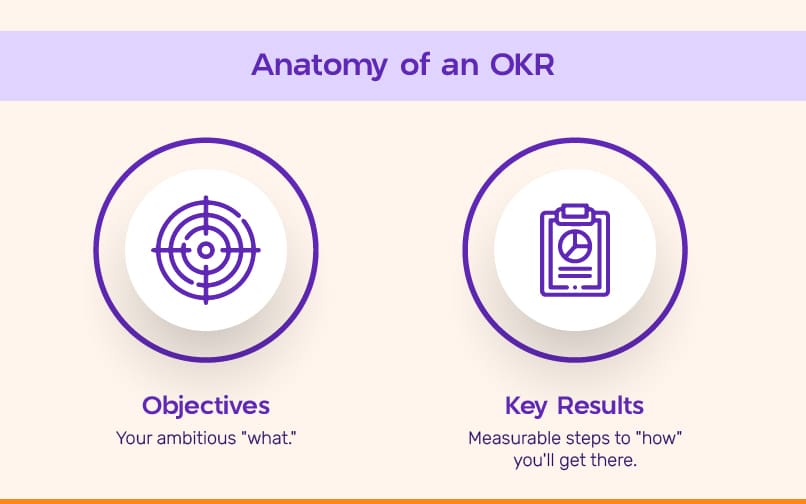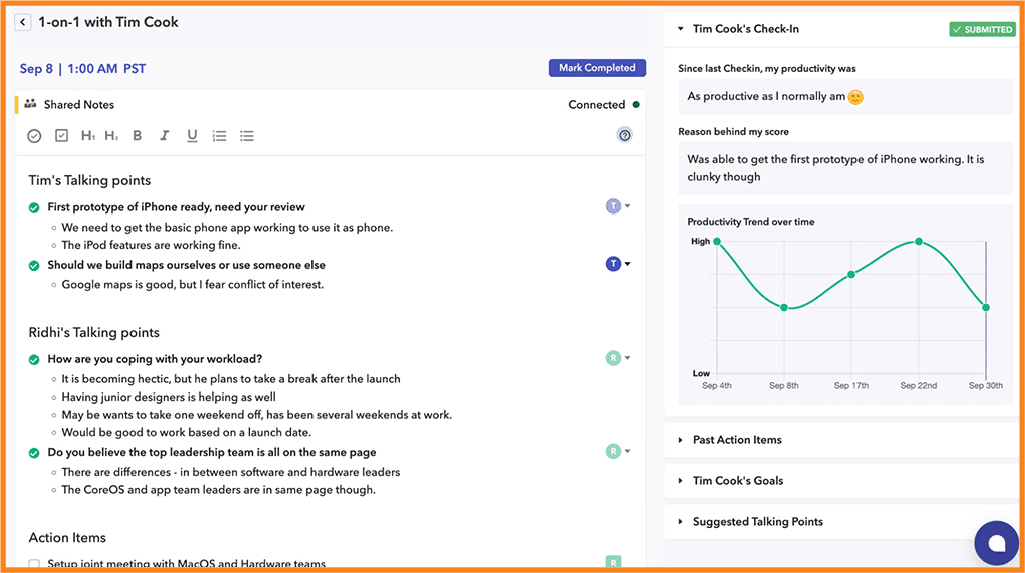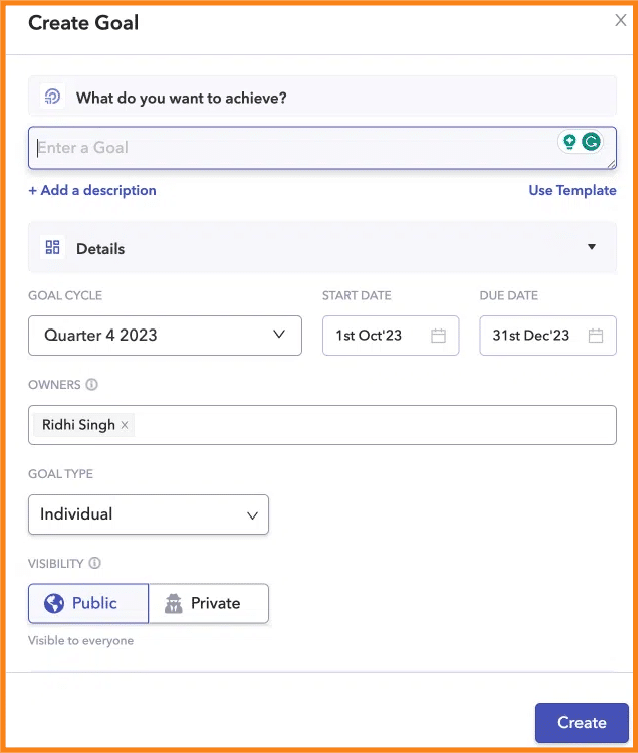Imagine being the HR leader in a fast-growing startup. Your team is great, but you know there’s room for improvement. The problem? Conducting performance evaluations feels like a shot in the dark without a clear plan. That’s where performance management planning comes in – the key to better evaluations and boosting employee productivity.
In this blog post, we discuss everything you need to know to plan your performance management process more effectively.

What is Performance Management Planning?
Performance management planning is the process of proactively outlining how you’ll evaluate and develop your employees’ performance. It’s a strategic process designed to:
- Align individual and team goals with organizational objectives: Ensure everyone understands how their contributions directly impact the company’s success.
- Drive continuous improvement: Equip employees with the tools and support needed to actively develop their skills and reach their full potential.
- Boost employee engagement: Foster a culture of open communication, honest feedback, and development, keeping your workforce motivated and engaged.
- Make data-driven decisions: Collect valuable insights from performance metrics to inform strategic decisions and track progress toward organizational goals.
By implementing performance management planning, you’re creating a structured and consistent approach to evaluation, ensuring both fairness for employees and measurable results for the organization.
What are the key elements of a successful performance management plan?
1. Clear Goals and Expectations
Every employee should know exactly what’s expected of them. Well-defined goals aligned with company objectives create focus and accountability from day one.
2. Regular Feedback and Coaching
Feedback shouldn’t wait for annual reviews. Ongoing coaching helps employees improve in real time and builds stronger manager-employee relationships.
3. Fair and Objective Evaluations
Performance should be measured using transparent, consistent criteria — not personal opinions. This ensures fairness and builds trust in the process.
4. Growth and Development Opportunities
A strong plan supports employees’ long-term success by offering learning programs, mentorship, and career advancement paths.
5. Recognition and Rewards
High performers deserve to be seen. A system for timely recognition — whether it’s a shout-out, bonus, or promotion — boosts morale and motivation.
6. A Consistent, Structured Process
Without structure, even the best plans fall apart. A standardized process ensures performance conversations happen regularly, and nothing slips through the cracks.
Forward-thinking organizations leverage technology like Peoplebox’s performance management platform to help them make their processes and performance management planning a breeze. Try it out yourself!
How to Implement a Good Performance Management Plan for Employees in Your Organization
Imagine you’re the HR manager at a thriving company, and you’re eager to elevate the performance of your talented team. Here’s a step-by-step journey to implement performance management planning seamlessly:
Step 1: Setting Organizational Goals
The foundation of an effective performance management system is built upon clear and measurable organizational objectives. These objectives should align with your company’s mission and vision, acting as the guiding light for your entire system. Here’s how to achieve this:
Brainstorm and prioritize goals: Collaborate with key stakeholders across various departments to identify and prioritize high-level objectives. Consider factors like market trends, customer needs, and your company’s long-term aspirations. Engage in open discussions to gather diverse perspectives, ensuring a comprehensive understanding of what truly matters to the organization.
Adopt Effective Goal-Setting Frameworks: OKRs, or Objectives and Key Results, are an impactful framework to adopt at this stage. They provide a structured and measurable way to set and track goals. Objectives define what you want to achieve, and Key Results quantify the progress. Incorporate OKRs into your goal-setting process to enhance clarity, accountability, and alignment with organizational priorities.

Cascade goals: Breaking down overarching organizational goals into smaller, departmental, and individual goals is crucial. This cascading approach creates a line of sight for employees, allowing them to understand how their individual contributions directly impact the bigger picture.
Pro Tip: To foster a sense of shared responsibility and motivation, involve employees in the goal-setting process. Solicit their input, encourage them to share insights, and consider their perspectives when defining objectives. This inclusivity not only enhances the quality of goals but also ensures that employees feel a genuine connection to the organizational mission.
Step 2: Establishing Performance Management Framework:
Now that you’ve set the stage for your performance management journey, it’s time to establish a robust framework that will guide you through the process. Here’s how you can do it:
Choose a performance management model: Outline the specific processes and procedures for managing performance within your organization. This includes determining how performance will be assessed, monitored, and reviewed. There are many performance management models that you can leverage. If you aren’t familiar with them, we recommend checking out our latest blog post, “Performance Management Models: A Comparison.”
Choose Relevant Performance Metrics and Evaluation Methods: Identify key performance indicators (KPIs) and metrics that align with your organizational objectives and individual job roles. These metrics should be measurable, meaningful, and directly tied to desired outcomes. For example:
- For customer service roles: Customer satisfaction score, average resolution time, first contact resolution rate.
- For sales roles: Sales quota attainment, average deal size, lead conversion rate.
- For marketing roles: Website traffic, conversion rate, social media engagement metrics, brand awareness metrics.
Use performance measurement platforms such as Peoplebox to gauge Key Performance Indicators (KPIs) against set targets, ensuring that your decisions consistently align with your overarching goals.

Role of Technology in Performance Management: Leverage technology to streamline and enhance your performance management processes. Invest in performance management software platforms, like Peoplebox’s performance management platform, that offer features such as goal setting and tracking, feedback collection and analysis, performance review automation, and reporting capabilities.
These tools can help automate administrative tasks, facilitate communication and collaboration, and provide real-time data and insights for informed decision-making.

Step 3: Developing Performance Goals
Now, it’s time to translate organizational strategic goals into individual and team performance objectives. And for this, as we discussed above, we will be looking into OKRs.
OKRs, or Objectives and Key Results, are a goal-setting framework used by many successful organizations, including Google and Intel. They are valuable because they provide clarity, focus, and alignment throughout the organization. Here’s how to set them effectively:
Set Ambitious Objectives: Objectives should be clear, inspiring, and ambitious. They should stretch employees to achieve their full potential while also aligning with the organization’s strategic priorities. For example, an objective could be to “Increase customer satisfaction by 20% within the next quarter.”
Define Measurable Key Results: Key Results are specific, measurable outcomes that indicate progress toward the objective. They should be quantifiable and achievable within a set timeframe. For instance, key results for the above objective could include “Reduce average response time to customer inquiries by 50%” or “Achieve a Net Promoter Score of 9 or higher.”

Let’s consider an example of an OKR for your marketing team
Objective: Increase Brand Visibility and Recognition
Key Results:
- Achieve a 30% increase in website traffic from organic search within the next quarter.
- Increase social media engagement by 25% measured through likes, shares, and comments.
- Secure coverage in at least five prominent industry publications or websites.
If you are new to OKRs, we understand it can seem daunting. To make it easier for you, we have curated a list of 70+ OKR examples that you can easily use for your organization.
Step 4: Designing Performance Reviews
Performance reviews, the next step in the performance management planning process, are a critical component of the employee performance management process, providing an opportunity for managers and employees to assess progress, provide constructive feedback, and set goals for the future. Here are key aspects to consider:
Frequency and format: Determine the frequency of the performance management cycle based on your chosen process, complemented by regular informal feedback sessions. At Peoplebox.ai, we recommend having weekly check-ins and one-on-ones in addition to monthly, quarterly, and annual performance reviews for an effective performance management plan.
Peoplebox lets you schedule and conduct dedicated one-on-one meetings for in-depth discussions and personalized goal setting.

Best practices for conducting one-on-one meetings:
- Set an agenda in advance: Ensure both parties know what topics will be discussed, allowing for preparation and a focused conversation.
- Create a safe and open environment: Encourage honest communication and active listening to foster open dialogue and feedback exchange.
- Focus on solutions, not just problems: While addressing challenges, emphasize collaboration on solutions and actionable steps for improvement.
- Follow up with notes and action items: Document key points discussed, decisions made, and next steps to ensure accountability and progress tracking.
Continuous feedback: Foster a culture of ongoing feedback through one-on-one meetings, project check-ins, or anonymous feedback tools. Timely and specific feedback allows for course correction and continuous improvement.
Conducting effective meetings: Coach managers with essential skills for conducting performance appraisals. If your organization is new to a streamlined performance management process, you can check out our blog post on performance management training for a comprehensive understanding of the process.
Here are some more tips to ace performance reviews in your organization:
Set Clear Expectations: Clearly communicate performance expectations, ensuring alignment with organizational goals.
Frequent Check-Ins: Conduct regular, informal check-ins to provide timely feedback and address concerns promptly.
Acknowledge Achievements: Recognize and celebrate employee achievements to boost morale and motivation.
Balance Feedback: Offer a balanced approach by highlighting strengths and addressing areas of improvement.
Link to Development: Connect performance assessments with personalized development plans and growth opportunities.
Data-Driven Insights: Utilize data and performance metrics to support feedback, making evaluations more objective.
Provide Training for Managers: Train managers in effective feedback delivery, fostering a positive and constructive review process.
Step 5: Communicating and Engaging the Employees:
In performance management, clear communication and employee engagement are essential for building trust, fostering a sense of ownership, and ultimately achieving desired outcomes. Here’s how you can ensure effective communication and engagement throughout the process:
Transparency is key: Clearly communicate the purpose and benefits of the performance management system to both employees and managers. This helps everyone understand their roles and responsibilities within the system.
Define expectations: Clearly outline performance expectations for each role. This includes outlining key responsibilities, desired skillsets, and desired behaviors. Utilize specific and measurable criteria to avoid ambiguity and ensure everyone is on the same page.
Open dialogue: Encourage open and honest two-way communication throughout the process. This allows employees to ask the right questions, share their perspectives, and provide feedback on the system itself.
Involve employees in goal setting: Encourage employees to participate in setting their own performance goals with guidance from their managers. This increases buy-in and fosters a sense of ownership towards achieving those goals.
With performance management platforms like Peoplebox, your employees can easily set measurable goals and make sure they are aligned with the organization’s goals.

Use Multiple Channels: Utilize various communication channels, such as team meetings, emails, and collaboration platforms. This ensures that information is disseminated effectively to cater to diverse communication preferences.

Pro Tip: Recognize and reward outstanding performance to showcase the value of the performance management system and motivate employees to strive for excellence.
Step 6: Evaluating and Adapting the Plan:
While performance management is a continuous process, one of the most important steps is evaluating and adapting the performance management plan. It should be a living document, not a static one. Here’s how to ensure its effectiveness:
Regular evaluations: Conduct periodic reviews to assess the effectiveness of the performance management system. Gather feedback from employees and managers through surveys, focus groups, or one-on-one discussions.
Collect feedback: Utilize various methods to gather quantitative and qualitative data on the system’s effectiveness. This might include employee satisfaction surveys, analysis of performance metrics, or tracking improvement in key areas.
Make adjustments: Based on the gathered feedback and data, adapt the performance management plan to address identified issues and improve its effectiveness. This could involve adjusting the review process, revising metrics, or incorporating new technology solutions.
By following these steps and continuously adapting your approach, you can implement a performance management planning system that fosters growth, engagement, and success within your organization. Remember, effective performance management is an ongoing journey, not a destination.
By investing in your people and creating a supportive environment for continuous learning and employee development, you can unlock the full potential of your team and drive your organization forward.
Use Peoplebox.ai for Performance Management
Face it—your current performance system is about as exciting as watching paint dry. Peoplebox.ai? It’s the electric shock your team desperately needs.
Peoplebox.ai cuts through the HR noise with a unified system that actually works. We’ve woven OKRs, real-time feedback, 1:1s, and reviews into one seamless experience that doesn’t just record performance—it actively drives it. While competitors force you into their box, we map to your unique culture, revealing talent insights that were hiding in plain sight.
Why Peoplebox.ai Makes Others Look Painfully Basic:
- Workflows that bend to your brilliance
- Analytics so sharp they could cut glass—9-box mapping that exposes truths your CEO needs to hear
- Integrations smoother than your best pickup line—Slack, HRIS, ATS—we’re already embedded in your digital ecosystem
- Interface so intuitive it practically reads your mind while pouring your coffee
Stop settling for the bargain basement of performance management. Your talent deserves the penthouse suite.
Ready for the upgrade you’ve been secretly craving? Contact us today!








